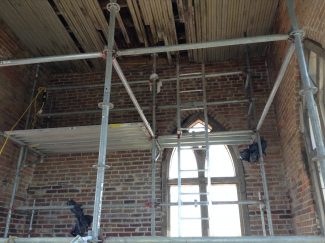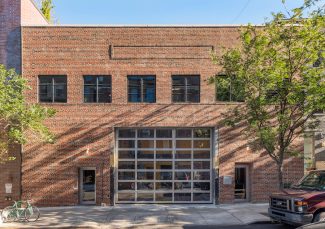May 21, 2019 Project of the Week

Project Name: Quapaw Quarter United Methodist Church
Company Name: Western Specialty Contractors
Project Location: Little Rock, Arkansas United States
Project Information/Details: Quapaw Quarter United Methodist Church in Little Rock, AR was designed in 1921 by prominent architectural firm Thompson and Harding. Built in stages from 1921 to 1926, the 44,000-square-foot, Gothic Revival-style church features a red brick and terra cotta façade. Recently, the historic restoration experts at Western Specialty Contractors – Little Rock, AR branch were challenged with repairing the church’s bell tower which was showing signs of instability and wear-and-tear. Western’s experts consulted with WER Architects to determine a plan of action for repairing the damaged bell tower. The tower’s interior brick wall was bulging out of the outside wall and required stabilization. Western was able to stabilize the tower’s brick wall by installing dry fix helical anchors and Heli Bar stitching rods at locations determined by the architect. Once the tower was stabilized, Western tuckpointed the masonry joints with matching mortar. Patching and tuckpointing the terra cotta at the roof level of the bell tower was performed using mortar and patching materials that matched the existing facade. The coating for the terra cotta was applied using the stippling method (creating a pattern using small dots simulating varying degrees of shading) to match the surrounding terra cotta appearance. Maintaining the original appearance of the church, which is listed on the National Register of Historic Places, was a priority. A roofing subcontractor was contracted to remove the existing bell tower roof and install new wood joists, roof hatch, TPO roof and access ladder. The roofing contractor discovered that the roof joist plan would not work with the existing conditions. The architect quickly amended the roof repair plan so that changes could be implemented without disrupting the schedule. Due to funding from the Arkansas Historic Preservation Program, the project had to be completed within two months. The restoration team was able to complete the project on time and within budget. About Western Specialty Contractors Family-owned and operated for more than 100 years, Western Specialty Contractors is the nation’s largest specialty contractor in masonry and concrete restoration, waterproofing and specialty roofing. Western offers a nationwide network of expertise that building owners, engineers, architects and property managers can count on to develop cost-effective, corrective measures that can add years of useful life to a variety of structures including: industrial, commercial, healthcare, historic, educational and government buildings, parking structures and sports stadiums. Western is headquartered in St. Louis, MO with 30 branch offices nationwide and employs more than 1,200 salaried and hourly professionals who offer the best, time-tested techniques and innovative technology. For more information about Western Specialty Contractors, visit www.westernspecialtycontractors.com.
May 14, 2019 Project of the Week

Project Name: Die Fuge (The Seam)
Company Name: Pickard Chilton
Project Location: Stuttgart, Germany
Project Information/Details: Pickard Chilton, an award-winning architecture studio best known for its innovative and cutting-edge design of corporate headquarters and campuses, announced that it was selected by global real estate firm Hines to master plan and design an urban development at Plieninger Straße 140 in Stuttgart, Germany. The firm was selected after being invited to participate in an international competition. The project encompasses a 125,000m2 (1.4million gsf) urban development that maximizes landscape open space while integrating itself into the area’s broader urban context. The development balances a mix of complementary uses on the site, including a hotel/boarding-house and a publicly-accessible ground level activated by café’s, restaurants, and amenity spaces. The project’s concept has been dubbed “Die Fuge” (“The Seam”) and focuses on the creation of new, innovative office space as well as an extensive public space located at the center of the master plan. Die Fuge’s curving form throughout the rest of the urban development will concentrate buildings to the east and west of the site. The design responds to the site’s topography, giving way to a series of green roof terraces with integrated photovoltaic panels, keeping sustainability at the core of the project. “We are honored to be considered to contribute this significant development to Stuttgart’s urban fabric,” said William D. Chilton FAIA, RIBA, principal of Pickard Chilton, “This project will allow us to create a next-generation urban development that will positively contribute to the neighborhood while incorporating key environmental goals that are reflective of our client’s vision for sustainable and impactful architecture in the 21st century.” Die Fuge’s “open office campus” encompasses flexible and modular H-shaped office buildings that will create exterior courtyards for drop-offs and access to bicycle storage and amenities. Inherent flexibility in planning supports long-term building resiliency and responsiveness to market conditions. “We are especially excited to create a new, inviting public space that will define this development,” added principal Chilton. “The project will be integral to creating much needed civic space in the area, joining an already impressive list of public space alternatives in the city, including the Schlossgarten and Killesberg parks.” The project is being developed by international real estate company Hines, in collaboration with Pickard Chilton, ARP Architektenpartnerschaft and Glück Landschaftsarchitektur.
May 07, 2019 Project of the Week

Project Name: STREB Lab for Action Mechanics (SLAM)
Company Name: CTA Architects
Project Location: Brooklyn, New York United States
Project Information/Details: CTA Architects, P.C. (CTA) has completed the exterior renovation of 51 North First Street. The 5,000-square foot, one-story building in the Williamsburg section of Brooklyn houses the non-profit STREB Lab for Action Mechanics (SLAM), a dance and theater performance venue and an open-access education and rehearsal space. The project was the first phase of the multi-phased renovation that will modernize and upgrade the entire popular venue. SLAM is the brainchild of Elizabeth Streb, a choreographer, performer, and teacher of contemporary dance, as well as an author, speaker, and MacArthur “Genius” Award-winner. SLAM is also the base of the STREB EXTREME ACTION COMPANY, which she founded in 1985. When Streb first founded SLAM in early 2003, the building, a former loading facility built in 1920 and once used by the adjacent Old Dutch Mustard Company, was vacant. After move-in, Streb kept the raw elements of the structure, such as the exposed concrete block walls and steel I-beams, as well as the street-level loading gate. In 2007, Streb had the opportunity to purchase the building. She did so with assistance from the New York City Department of Cultural Affairs (DCLA), City Council, Mayor’s Office, and Brooklyn Borough President’s Office. More recently, the City again stepped in to provide a total of $4,886,000 in capital funding to renovate the building: over the last seven years, the Mayor’s Office gave a total of $2,404,000, including support from Mayor Bill de Blasio; New York City Council allocated $1,732,000 with support from Councilman Stephen Levin; and Eric L. Adams, Brooklyn Borough President, allocated $750,000 for the project. These funds will be administered by DCLA, which, through its capital program, supports construction and renovation projects at cultural organizations throughout the five boroughs of New York City. “I am excited about the completion of the exterior renovation of our building. The studio’s new, welcoming façade reflects the quality of our programs and fits very well into the mixed industrial and residential vibe of our Williamsburg neighborhood,” said SLAM founder Elizabeth Streb. “We were very lucky to collaborate with an architect who understood and appreciated both the historic character of our building and the need to create an inviting threshold to our performance and dance space. Craig Tooman, along with his CTA Architects team, has devised a very creative approach that allowed us to complete the exterior renovation within a limited budget, while preserving and building upon the history of our facility. CTA even convinced the design and construction team members to donate many of the materials – the garage door, the windows, the glass blocks, even the bricks and mortar. We would never have been able to renovate our studio without Craig’s support and involvement,” she added. The CTA principal in charge of the project, Craig Tooman, AIA, LEED-AP, has been on the SLAM Board of Directors for the past decade. “The structure’s 24-foot-high ceilings and 50'x100' clear-span provide an excellent space for the dance company’s rehearsals and classes. SLAM’s ability to accommodate up to 150 people at a time in the performance space has made it an integral part of the community. My family has been taking advantage of SLAM classes and performances for years. We at CTA wanted to do all we could to restore the facility, so it could continue to provide its services to the people of this city for years to come,” he said. Beginning repair work with the New York City grants requires a great deal of coordination to ensure that work is done in accordance with stipulations put forth by the grantees, the oversight agencies, and the Building Code. The façade, however, has been in dire need of repair for some time; work needed to begin as soon as possible. The existing brick was cracking, bowing, and bulging; the steel-framed factory-type single-pane casement windows were in a state of disrepair and far from being energy efficient. Thus, the SLAM Board of Directors decided to break the work into two distinct phases. Phase I, just completed, repaired the façade. This work has been made possible with financial support from the Howard Gilman Foundation, New York Community Trust - LuEsther T. Mertz Advised Fund, Booth Ferris Foundation, and a circle of generous individuals. In addition, the Phase I of the renovation would not be possible without the generous donation of goods and services by multiple companies. CTA provided its Phase I architectural services on a pro bono basis. Services were also provided pro bono by the expeditor, Municipal Building Consultants, Inc. Belden Brick donated the bricks for the project at the cost of delivery only. Skyline Windows donated the replacement casement upper floor windows. Taurino Management donated five gallons of intumescent paint for the fireproofing of the steel lintels at the window and door openings, while SAGE Builders Corporation donated the partial cost of the two aluminum swinging doors with full-glass lights. Total Structural Concepts, Inc., which served as general contractor, performed its work at cost. Phase II, to be fully funded by the nearly $4.9 million in City grants, will include the installation of an interior mezzanine and elevator, which will provide additional space for dancers and administration, as well as offices and a conference room. This phase also includes the redesigning of the lobby, the creation of a dancer dressing room/green room, and energy-efficient upgrades, such as replacing the existing garage door with a custom aluminum and glass insulated door, the installation of wall and ceiling insulation, new ceiling fans to circulate air within the space and energy-efficient light fixtures. SLAM is open seven days a week, year-round. Thus, over the course of a year, is serves nearly 10,000 people: 5,000 audience members at nearly 40 shows; 800 students weekly at nearly 60 weekly classes; 3,000 city school children and community organization constituents including marginalized and at-risk youth; 200 artists who rent SLAM to create and present work, teach, and take classes; 600 tweens and teens who attend monthly SLAM ACTION CLUBs; and 250 children who attend SLAM summer camp. All of SLAM’s activities – rehearsals, demonstrations, workshops, and classes – are open to the public. The building also accommodates SLAM’s renowned trapeze rig. Phase I Details Phase I restored and stabilized the front façade, and significantly improved the facility’s energy efficiency. It also set the stage for the future interior work of Phase II. The project begun with the replacement of all of the face brick. The bricks were set in custom-colored type-N mortar to match the original mortar color. According to Alanna Jaworski, AIA, CTA’s project manager, “We raised the upper windows by about a foot-and-a-half to accommodate the new interior mezzanine that will be added in Phase II. The new operable aluminum casement windows are highly energy efficient, far more than those we have replaced.” In addition, Phase I work included widening of the two swinging side doors, and the construction of a raised parapet. Challenges One of the biggest challenges involved safety and logistics, as SLAM – open seven days per week – was at no time closed for any of the work. “Even when we were demolishing the parapet and had the wall open to the sky above the level of the window lintels, the facility still remained open,” said Chelsea Brandt, CTA’s project designer. This wall opening was due to the need to replace both the face brick and the backup, from the existing window sill level all the way up through the parapet. “Of course, we did this in the least obtrusive way possible, working in phases, using temporary protection and sidewalk level fence enclosure, so only small parts of the façade were open at any one time,” she continued. Outside, the team used a plywood protection and temporary tarps. The project team protected the interior from debris through the use of temporary sheeting and by separating the areas under construction from the rest of the facility. Another challenge was budget, as SLAM is a non-profit organization with limited funds. However, as noted above, members of the design and construction team donated services and materials free or at cost. In addition, CTA has been able to meet the project’s objectives through value engineering solutions such as using CMU back-up in lieu of brick back-up, by raising the brick parapet to a legal height of 42” above the finished roof surface instead of installing a new steel railing inboard of the existing parapet, and by reusing the existing mechanical louvers instead of purchasing new ones CTA Architects Established in 1987, CTA Architects is a prominent architectural design firm based in New York City. Three principals lead the 50-person firm: Craig Tooman, AIA, LEED AP; Daniel J. Allen, AIA; and Christa E. Waring, AIA, LEED AP. CTA’s design focus and experience span new design, historic preservation, and restoration work in the civic, multi-family residential, commercial, institutional, educational, and public markets. The firm holds term contracts with the New York City School Construction Authority (SCA), the New York State Office of General Services (OGS), the New York City Department of Design and Construction (DDC), and the City University of New York (CUNY). CTA’s recent projects in New York City include nine Universal Pre-Kindergartens and one 3K school for the NYC SCA; design work the Coney Island Prep, Harlem Village Academy, and Growing Up Green School; the historic landmark restorations of the 36 Gramercy Park East façade and the City Cinemas Village East Theater; exterior renovations to the Fifth Avenue Armory; the rehabilitations of the Grand Street Guild, Haven Plaza, and George Hardy and St. Francis apartment complexes totaling 1,175 units for the Archdiocese of New York; and the exterior renovation of the six-building Morningside Gardens co-op campus. The studio’s new design work also includes SARA NY Design Award winner 17 Pitt Street and the Lower Eastside Girls Club. The firm’s projects also include the exterior renovations to the New York State Legislature Building in Albany, New York as well as an adaptive re-use of the historic Arcade Hotel in Bridgeport, CT’s Downtown South Historic District. CTA’s work has been widely recognized through regional and national awards, including the Exterior Preservation Award from Landmark West!, Residential Architect Design Award of Merit, The Society of American Registered Architects National and New York Chapters’ Design Awards, several Lucy G. Moses preservation awards from the New York Landmarks Conservancy, and the Victorian Society of America Metropolitan Chapter Preservation Awards


